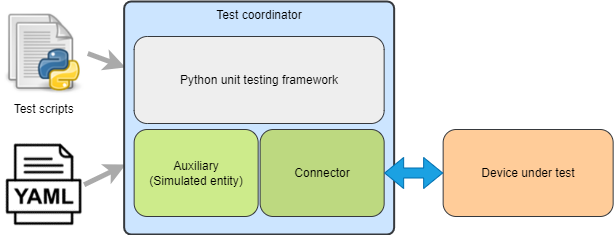Pykiso Design
Introduction
The pykiso Integration Test Framework (ITF) build in a modular and configurable way, which aims to enable the user, to write and run tests on hardware. Pykiso is build to orchestrate the entities ( e.g. device under test ) and services ( e.g. flash the target ) which are involved in the test. The Testing Framework can be used for both white-box and black-box testing as well as in the integration and system testing.
Quality Goals
The Framework tries to achieve the following quality goals:
Quality Goal (with prio) |
Scenarios |
|---|---|
Portability |
The Framework shall run on linux, windows, macOS |
The Framework shall run on a raspberryPI or a regular laptop |
|
Modularity |
The Framework shall allow me to implement complex logic and to run it over any communication port |
The Framework shall allow me to add any communication port |
|
The Framework shall allow me to use private modules within my tests if it respects its APIs |
|
The Framework shall allow me to define my own test approach |
|
Correctness |
The Framework shall verify that its inputs (test-setup) are correct before performing any test |
The Framework shall execute the provided tests always in the same order |
|
Usability |
The Framework shall feel familiar for embedded developers |
The Framework shall feel familiar for system tester |
|
The Framework shall generate test reports that are human and machine readable |
|
Performance (new) |
The Framework shall use only the right/reasonable amount of resources to run (real-time timings) |
Design Overview

The pykiso ITF is built in a modular and configurable way with abstractions for both, entities (e.g. simulated counterpart for the device under test) and communication (e.g. UART or TCP/IP).
As illustrated in Figure 1, the pykiso ITF is composition of a test-coordinator, auxiliaries and their corresponding connectors.
The tests leverage the python unittest-Framework which has a similar flavor as many available major unit testing Frameworks and thus comes with an ecosystem of tools and utilities.
Test Coordinator
The test-coordinator is the central module setting up and running the tests. Based on a configuration file (in YAML), it does the following:
instantiate the selected connectors
instantiate the selected auxiliaries
provide the auxiliaries with the matching connectors
generate the list of tests to perform
provide the testcases with the auxiliaries they need
verify if the tests can be performed
for remote tests (see Remote Test) flash and run and synchronize the tests on the auxiliaries
gather the reports and publish the results
Auxiliary
The auxiliary provides to the test-coordinator an interface to interact with the physical or digital device under test. It can be seen as a helping hand for the test-coordinator to communicate with the device under test, designated by the term auxiliary. It is composed by 2 blocks:
instance creation / deletion
connectors to facilitate interaction and communication with the device (e.g. messaging with UART)
If for example an auxiliary needs to interact with cloud services, it could have:
A communication channel (cchannel) like REST
Create an Auxiliary
Detailed information can be found here How to create an auxiliary.
Existing Auxiliarys
acroname_auxiliary - control an acroname usb hub.
communication_auxiliary - used to for raw byte communication.
dut_auxiliary - allows to flash and run test on the target device.
instrument_control_auxiliary - interface to arbitrary instrument (e.g. power supplies).
mp_proxy_auxiliary - multiprocessing proxy auxiliary
proxy_auxiliary - connect multiple auxiliaries to one unique connector.
record_auxiliary - logging from connector.
simulated_auxiliary - simulated device under test.
Using UDS protocol - uds requests.
UDS protocol handling as a server - simulated uds ecu.
ykush_auxiliary - control Yepkit USB hub.
can_auxiliary - auxiliary enables you to read write can messages
Detailed information about included auxiliarys can be found here Existing Auxiliaries.
Connector
The communication between the test-coordinator and the device under test via the auxiliary is enabled by the corresponding connector. The connector can be used either as a communication channel or a flasher.
Communication Channel
The Communication Channel - also known as cchannel - is the medium which enables the communication with the device under test. Example include UART, UDP, USB, REST,… The communication protocol itself can be auxiliary specific.
Create a Connector
Detailed information can be found here How to create a connector.
Dynamic Import Linking
The pykiso Framework was developed with modularity and reusability in mind. To avoid close coupling between testcases and auxiliaries as well as between auxiliaries and connectors, the linking between those components is defined in a config file (see How to make the most of the config file) and performed by the TestCoordinator.
Different instances of connectors and auxiliaries are given aliases which identify them within the test session.
Let’s say we have this (abridged) config file:
connectors:
my_chan: # Alias of the connector
type: ...
auxiliaries:
my_aux: # Alias of the auxiliary
connectors:
com: my_chan # Reference to the connector
type: ...
The auxiliary my_aux will automatically be initialised with my_chan as its com channel.
When writing your testcases, the auxiliary will then be available under its defined alias.
from pykiso.auxiliaries import my_aux
The pykiso.auxiliaries is a magic package that only exists in the pykiso package after the TestCoordinator has processed the config file.
It will include all instances of the defined auxiliares, available at their defined alias.
Usage
Please see How to make the most of the config file to have a deep-dive on how the pykiso configuration work.
Please see How to make the most of the tests to have a deep-dive on how pykiso tests work.